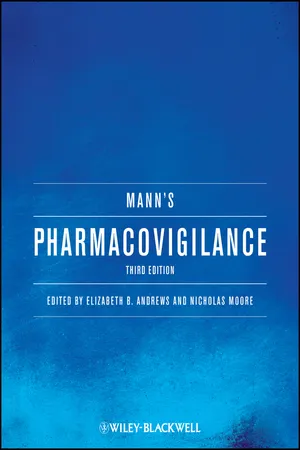
Mann's Pharmacovigilance
- English
- ePUB (mobile friendly)
- Available on iOS & Android
Mann's Pharmacovigilance
About this book
Highly Commended at the BMA Medical Book Awards 2015
Mann's Pharmacovigilance is the definitive reference for the science of detection, assessment, understanding and prevention of the adverse effects of medicines, including vaccines and biologics.
Pharmacovigilance is increasingly important in improving drug safety for patients and reducing risk within the practice of pharmaceutical medicine. This new third edition covers the regulatory basis and the practice of pharmacovigilance and spontaneous adverse event reporting throughout the world. It examines signal detection and analysis, including the use of population-based databases and pharmacoepidemiological methodologies to proactively monitor for and assess safety signals. It includes chapters on drug safety practice in specific organ classes, special populations and special products, and new developments in the field.
From an international team of expert editors and contributors, Mann's Pharmacovigilance is a reference for everyone working within pharmaceutical companies, contract research organisations and medicine regulatory agencies, and for all researchers and students of pharmaceutical medicine.
The book has been renamed in honor of Professor Ronald Mann, whose vision and leadership brought the first two editions into being, and who dedicated his long career to improving the safety and safe use of medicines.
Frequently asked questions
- Essential is ideal for learners and professionals who enjoy exploring a wide range of subjects. Access the Essential Library with 800,000+ trusted titles and best-sellers across business, personal growth, and the humanities. Includes unlimited reading time and Standard Read Aloud voice.
- Complete: Perfect for advanced learners and researchers needing full, unrestricted access. Unlock 1.4M+ books across hundreds of subjects, including academic and specialized titles. The Complete Plan also includes advanced features like Premium Read Aloud and Research Assistant.
Please note we cannot support devices running on iOS 13 and Android 7 or earlier. Learn more about using the app.
Information
1
Introduction: Updated from Second Edition
Background
| Brand name (drug substance) | Year action taken | Major safety concern |
|---|---|---|
| Secholex (polidexide) | 1975 | Safety concerns because of impurities |
| Eraldin (practolol) | 1975 | Oculomucocutaneous syndrome |
| Opren (benoxaprofen) | 1982 | Hepatotoxicity, serious skin reactions |
| Devryl (clomacran phosphate) | 1982 | Hepatotoxicity |
| Flosint (indoprofen) | 1982 | Gastrointestinal toxicity |
| Zomax (zomepirac) | 1983 | Anaphylaxis |
| Osmosin (indomethacin-modified release) | 1983 | Small-intestine perforations |
| Zelmid (zimeldine) | 1983 | Neurotoxicity |
| Flenac (fenclofenac) | 1984 | Lyell's syndrome |
| Methrazone (feprazone) | 1984 | Serious skin reactions, multisystem toxicity |
| Althesin (alphaxolone plus alphadolone) | 1984 | Anaphylaxis |
| Pexid (perhexilene) | 1985 | Hepatotoxicity, neurotoxicity |
| Suprol (suprofen) | 1986 | Nephrotoxicity |
| Merital (nomifensine) | 1986 | Hemolytic anemia |
| Unicard (dilevalol) | 1990 | Hepatotoxicity |
| Glauline eye drops 0.6% (metipranolol) | 1990 | Uveitis |
| Halcion (triazolam) | 1991 | Psychiatric reactions |
| Micturin (terodiline) | 1991 | Arrhythmias |
| Teflox (temafloxacin) | 1992 | Multisystem toxicity |
| Centoxin (nebacumab) | 1993 | Mortality |
| Roxiam (remoxipride) | 1994 | Aplastic anemia |
| Volital (pemolin) | 1997 | Hepatotoxicity |
| Romazin (troglitazone) | 1997 | Hepatotoxicity |
| Serdolect (sertindole) | 1998 | Arrhythmias |
| Tasmar (tolcapone) | 1998 | Hepatotoxicity |
| Ponderax (fenfluramine) | 1998 | Cardiac valvular disease |
| Adifax (dexfenfluramine) | 1998 | Cardiac valvular disease |
| Posicor (mibefradil) | 1998 | Drug interactions |
| Trovan (trovafloxacin) | 1999 | Hepatotoxicity |
| Grepafloxacin (Raxar) | 1999 | QT interval prolongation |
| Prepulsid (cisapide) | 2000 | QT interval prolongation |
| Alec (pumactant) | 2000 | Adverse comparative trial results |
| Droleptan (droperidol) | 2001 | Increased cardiac risks |
| Lipobay (cerivastatin) | 2001 | Rhabdomyolysis |
| Kava-Kava | 2001 | Liver toxicity |
| Anorectic agents (amfepramone, phentermine) | 2000 | Heart valve disorders |
| Vioxx (rofecoxib) | 2004 | Increased cardiovascular event risks |
| Non-proprietary (co-proxamol) | 2005 | Use in suicide |
| Bextra (valdecoxib) | 2005 | Stevens–Johnson syndrome |
| Prexige (lumiracoxib) | 2007 | Hepatotoxicity |
| Carisoma (carisoprodol) | 2007 | Abuse potential |
| Trasylol (aprotinin) | 2007 | Death following cardiac surgery |
| Accomplia (rimonabant) | 2008 | Depression, Suicide |
| Raptiva (efalizumab) | 2009 | Progressive Multifocus Leukoencephalopathy |
| Reductil (sibutramine) | 2010 | Cardiovascular mortality |
| Avandia (rosiglitazone) | 2010 | Increased cardiovascular event risk |
Table of contents
- Cover
- Table of Contents
- Title page
- Copyright page
- Contributors
- Foreword
- 1: Introduction: Updated from Second Edition
- 2: History of Pharmacovigilance
- Part I: The Regulatory Basis of Pharmacovigilance
- Part II: Pharmacovigilance Systems
- Part III: Signal Detection/Generation in Spontaneous Reporting Programs and Other Sources: From Spontaneous Reporting to Pharmacoepidemiology
- Part IV: Pharmacovigilance and Drug/System Organ Classes
- Part V: Current Topics
- Part VI: Training and Education and Directions
- Supplemental Images
- Index
- End User License Agreement